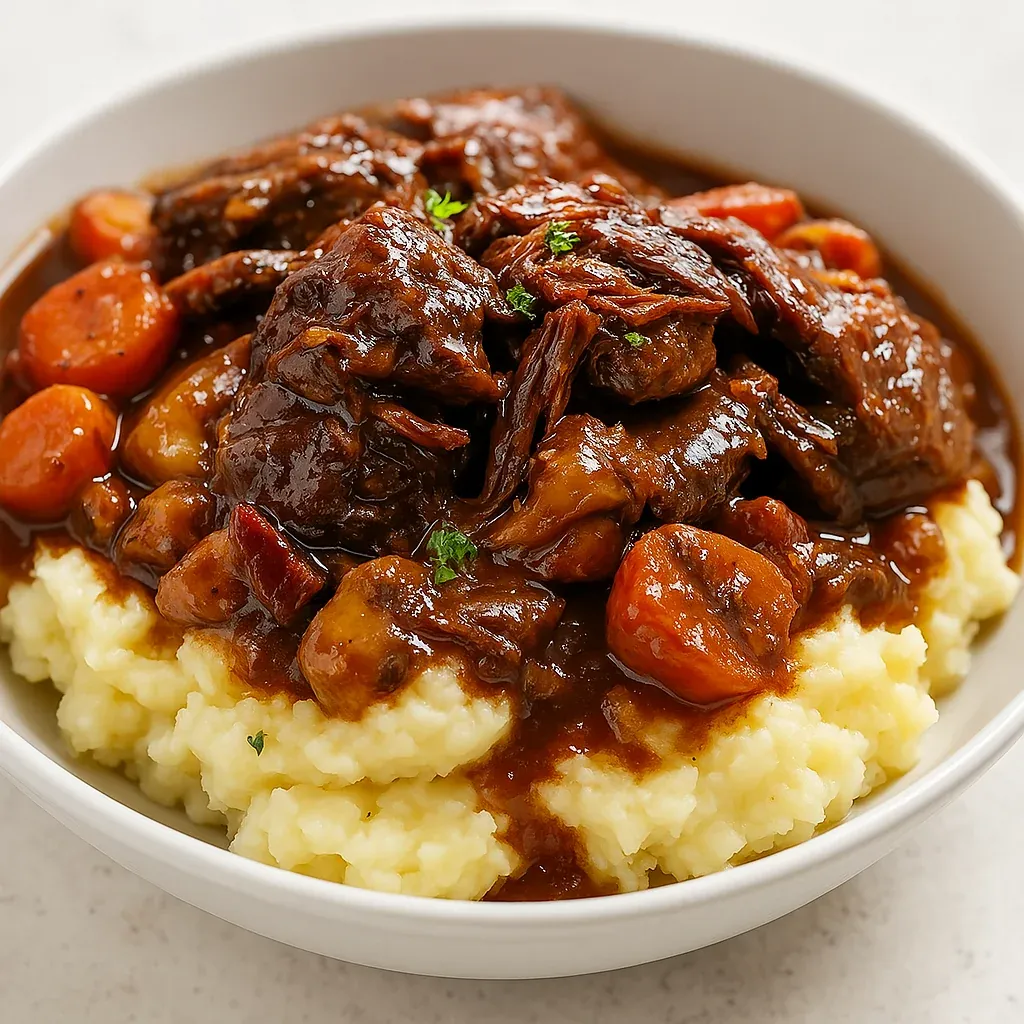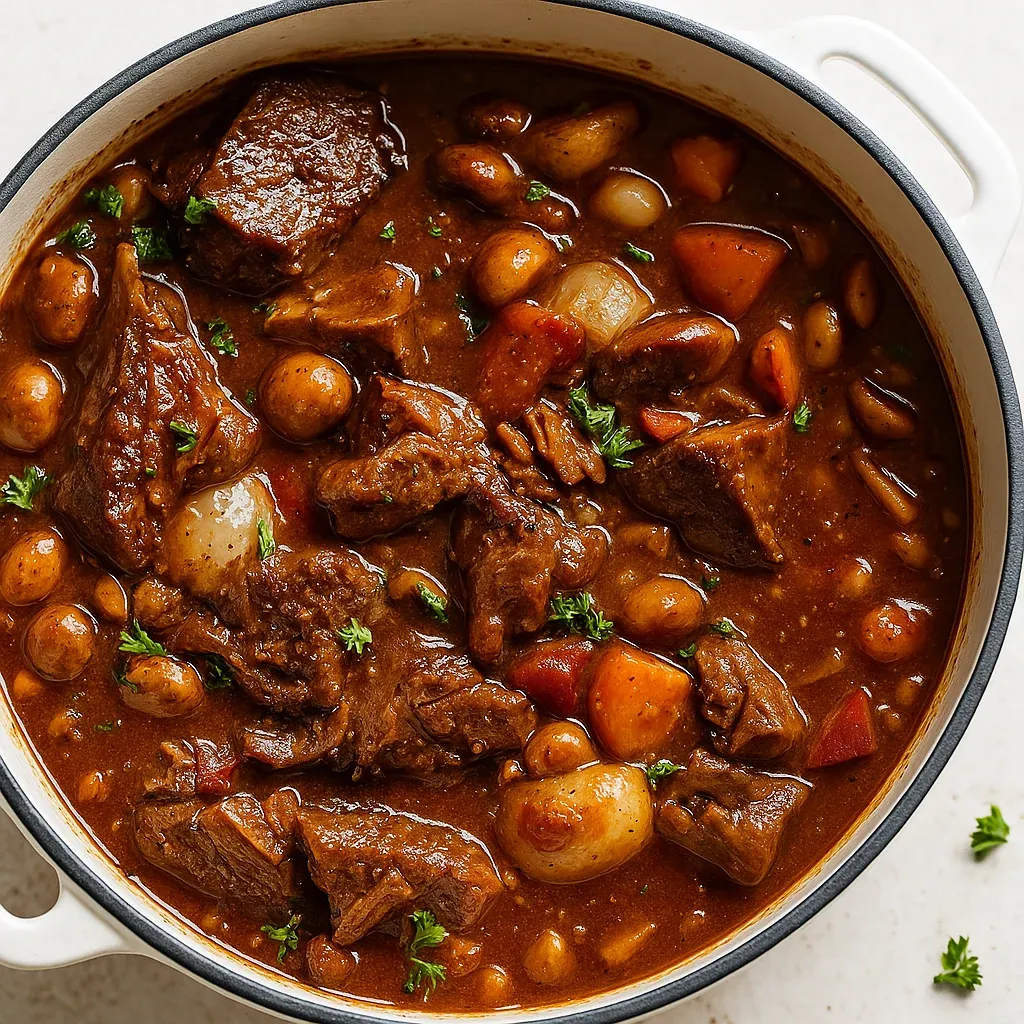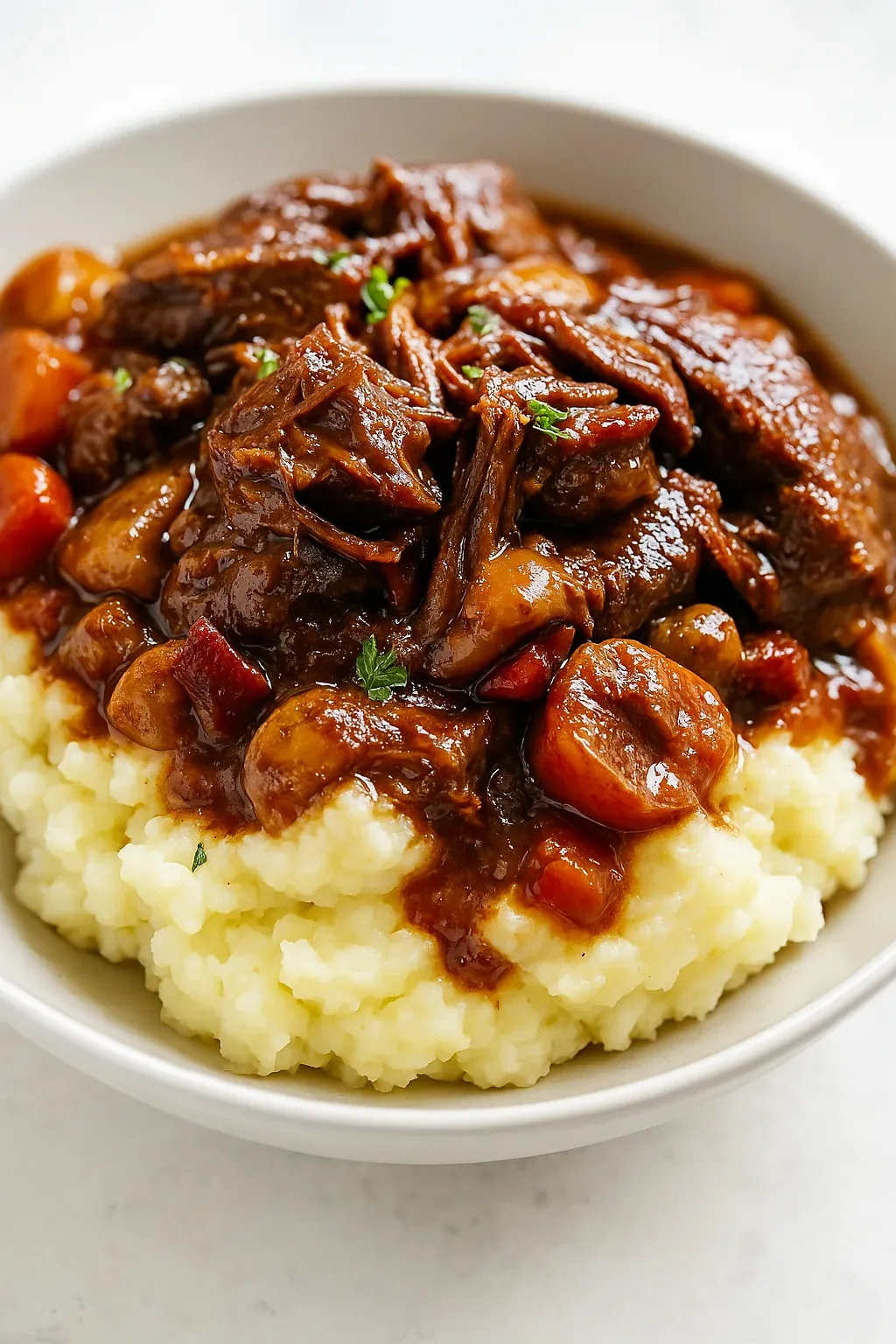 Pin it
Pin it
Rich, tender chunks of beef swimming in a velvety red wine sauce with bacon, pearl onions, and earthy mushrooms create the ultimate comfort food experience. This classic French dish transforms humble ingredients into something truly magical through patient, loving preparation. The first time I made Julia Child's Beef Bourguignon, I was intimidated by the lengthy process, but the incredible depth of flavor made every minute worth it. Now it's become our family's special occasion meal that never fails to impress even the pickiest eaters at our table.
The first time I served this to my extended family during the holidays, my brother-in-law (who typically talks through meals) fell completely silent. All I could hear was the occasional appreciative murmur as everyone savored each bite. The transformation that happens when these simple ingredients meld together is nothing short of culinary alchemy. Even my teenager, who claims to hate onions, devours this without picking around them – the ultimate cooking victory!
Ingredients You'll Need
- 3 pounds beef brisket or chuck steak – Provides the foundation of the dish and becomes meltingly tender through slow cooking. Look for well-marbled pieces with some fat, which breaks down during cooking to create richness and prevent the meat from drying out. The connective tissue in these cuts turns into gelatin during the long cooking process, creating that silky mouthfeel that makes this dish special.
- 6 ounces bacon – Adds a smoky depth and richness that elevates the entire dish. Choose thick-cut bacon for the best texture and flavor. The rendered bacon fat becomes the first layer of flavor for browning the beef, creating those beautiful caramelized notes that are essential to a good bourguignon.
- 1 large carrot and white onion – Creates the aromatic base that infuses the sauce with sweetness and depth. Select firm, fresh vegetables for the clearest flavor. The carrot adds a subtle sweetness that balances the acidity of the wine, while the onion provides essential savory notes.
- 6 garlic cloves – Provides that unmistakable aromatic foundation that permeates the entire dish. Fresh garlic is non-negotiable here – the pre-minced variety won't deliver the same complex flavor. Some cloves cook slowly with the stew, while others are added later with the mushrooms for brightness.
- 3 cups red wine – The soul of beef bourguignon, creating its distinctive rich flavor and color. Traditional choices include Burgundy (from the Bourgogne region in France), Merlot, Pinot Noir, or Chianti. Always choose a wine good enough to drink – the flavor concentrates as it cooks, so quality matters tremendously.
- Beef stock – Provides the liquid base that allows for long, slow cooking while adding meaty depth. Homemade is best, but a good quality store-bought stock works well too. The gelatin in the stock combines with the wine to create that silky sauce that clings beautifully to each bite of meat.
- Fresh herbs – Thyme and parsley add brightness and complexity. Fresh herbs make a noticeable difference in this dish, though dried can be substituted in a pinch. The thyme infuses during cooking, while fresh parsley adds color and a pop of fresh flavor just before serving.
- 1 pound fresh mushrooms – Adds earthy flavor and meaty texture. Choose small button or cremini mushrooms with firm caps and clean stems. The separate preparation with butter and garlic keeps them plump and flavorful instead of shriveling into the sauce.
Step-by-Step Cooking Instructions
- Step 1:
- Prepare your ingredients thoughtfully – Lay everything out before you begin, with the meat at room temperature for even browning. Pat the beef very dry with paper towels – this is crucial for proper searing. Cut the meat into generous 2-inch chunks rather than smaller pieces, which helps maintain juiciness during the long cooking process. Chop the vegetables uniformly so they cook at the same rate. Open your wine to let it breathe while you begin cooking.
- Step 2:
- Create the flavor foundation with bacon – Heat olive oil in a large Dutch oven until it shimmers, then add the chopped bacon. Cook it slowly until the fat renders and the bacon becomes crisp and golden, about 5-6 minutes. The sizzling sound should be gentle – too hot and the bacon will burn rather than render properly. Using a slotted spoon, transfer the bacon to a side dish, leaving behind the flavorful fat that will become the base for browning the beef.
- Step 3:
- Develop deep flavor through careful browning – Work in small batches when searing the beef – overcrowding causes steaming instead of browning. Place each piece in the hot bacon fat with enough space between chunks to allow steam to escape. Resist the urge to move the meat too soon; let each side develop a dark crust before turning. This caramelization creates the rich foundation of flavor that defines a great bourguignon. As each batch finishes, transfer it to the dish with the bacon.
- Step 4:
- Build the aromatic base – In the same pot with the remaining fat, add the diced onions and sliced carrots. Sauté until they soften and begin to take on color, about 3-4 minutes. The vegetables should pick up the browned bits from the bottom of the pot – this is pure flavor. Add four cloves of minced garlic and cook just until fragrant, about 30-45 seconds. Be careful not to burn the garlic, which turns bitter quickly.
- Step 5:
- Create the sauce foundation – Return the bacon and browned beef to the pot with any accumulated juices – this is liquid gold that contains concentrated flavor. Season with salt and pepper, then sprinkle flour over everything and stir constantly for several minutes. This step creates a roux that will thicken your sauce beautifully. The flour should coat everything evenly and take on a slightly toasted aroma as it cooks.
- Step 6:
- Develop depth with liquid ingredients – Add the pearl onions, then pour in the wine slowly, using a wooden spoon to scrape up all the flavorful browned bits from the bottom of the pot. This deglazing step is crucial for incorporating those caramelized flavors into your sauce. Add enough beef stock to barely cover the meat, then stir in tomato paste and crushed bouillon. The liquid should have a deep reddish-brown color at this point.
- Step 7:
- Infuse with herbs and begin slow cooking – Add fresh thyme, parsley, and bay leaves to the pot. Bring everything to a gentle simmer on the stovetop first, watching for the first small bubbles around the edges. Cover and transfer to a preheated 350°F oven for the traditional method. The covered pot creates a moist, gentle heat that slowly breaks down the tough fibers in the meat while allowing the flavors to meld. Check occasionally – the liquid should maintain a very gentle simmer, not a boil.
- Step 8:
- Prepare the mushrooms separately – About 10 minutes before the meat is finished cooking, prepare the mushrooms. Melt butter in a separate skillet until it foams, then add remaining garlic and cook just until fragrant. Add quartered mushrooms to the hot pan and shake occasionally to coat with butter as they cook. Let them develop a golden-brown color without stirring too much – about 5 minutes total. Season lightly with salt and pepper. The separate cooking keeps the mushrooms plump and flavorful.
- Step 9:
- Perfect the sauce – Once the meat is fork-tender, carefully strain the cooking liquid into a saucepan, separating it from the meat and vegetables. Return the solids to the Dutch oven and add the sautéed mushrooms. Skim any excess fat from the surface of the strained liquid, then simmer it for a few minutes until it reaches the perfect consistency – thick enough to coat the back of a spoon. This concentrated sauce should be velvety and glossy, clinging beautifully to the meat and vegetables.
- Step 10:
- Reunite and finish the dish – Pour the reduced sauce back over the meat and vegetables, gently stirring to combine without breaking up the tender beef chunks. Allow everything to simmer together for just 2-3 minutes for the flavors to marry. Taste and adjust the seasoning with salt and pepper if needed. The final dish should have a beautiful balance of rich, savory, and slightly tangy notes from the wine, with the meat so tender it falls apart with gentle pressure.
 Pin it
Pin it
The Perfect Make-Ahead Dish
One of the many wonderful qualities of Beef Bourguignon is how it improves with time. The first night I made it, we enjoyed it immensely, but when I reheated the leftovers the next evening, the transformation was remarkable. The flavors had married and mellowed, with the wine integrating perfectly into the sauce. Now I deliberately make it a day ahead when expecting company, which not only results in better flavor but also allows me to spend time with guests instead of in the kitchen.
Choosing Your Cooking Method
While the traditional oven method produces exceptional results, I've experimented with all four cooking techniques mentioned in the recipe. The slow cooker version has saved me on busy days when I need dinner ready upon returning home. The pressure cooker method delivers remarkably tender meat in a fraction of the time when I've forgotten to plan ahead. Each approach has its merits, but they all create that signature rich flavor that defines this classic dish.
Serving Suggestions
Beef Bourguignon needs little accompaniment beyond something to capture its glorious sauce. Classically, it's served over buttered egg noodles, but we often enjoy it with creamy mashed potatoes that serve as the perfect canvas for the rich gravy. For a lighter option, try roasted garlic mashed cauliflower. A simple green salad with a bright vinaigrette provides welcome contrast to the richness of the stew. Crusty French bread for sauce-sopping is never a bad idea.
The Wine Question
Selecting the right wine for your Bourguignon makes a noticeable difference in the final dish. While traditional recipes call for Burgundy wine (from the Bourgogne region where the dish originates), any medium-bodied red wine with good acidity works beautifully. I've had excellent results with Pinot Noir, which provides elegance, and Merlot, which adds richness. Avoid very tannic wines like young Cabernet Sauvignon, which can become bitter during long cooking.
My grandmother always said that good cooking is about respect – for the ingredients, the process, and the people you're feeding. The first time I made Beef Bourguignon, I nearly rushed the browning step because it was taking so long to do in batches. I'm so glad I didn't. Those extra minutes of careful browning created a depth of flavor that transformed the dish from good to extraordinary. Now browning the meat is almost meditative for me – a reminder that good food can't be rushed.
 Pin it
Pin it
I learned the importance of proper deglazing from a cooking disaster years ago. I was making Beef Bourguignon for a special anniversary dinner and got distracted when adding the wine, failing to scrape up those beautiful browned bits. The resulting dish was good but lacked the depth I knew it should have. Now I take my time with each step, especially making sure to capture all those caramelized flavors that make this dish so remarkable.
This Beef Bourguignon is more than just dinner – it's an experience to be savored. The process of creating it honors the French tradition of transforming humble ingredients into extraordinary meals through technique and patience. When you set this dish on the table, surrounded by family or friends, you're not just serving food; you're creating a moment that engages all the senses and invites everyone to slow down and truly taste each carefully crafted bite. It reminds us that cooking with love and attention creates something greater than the sum of its parts – it creates memories.
Frequently Asked Questions
- → Can I make Beef Bourguignon ahead of time?
- Absolutely! It actually tastes better when made a day ahead. Let it cool completely, cover and refrigerate. Before serving, take it out of the fridge for at least an hour, then reheat gently for about 10 minutes, basting the meat with the sauce.
- → Which cooking method is best for Beef Bourguignon?
- The traditional oven method gives the most authentic results, but all methods work well. The slow cooker is most convenient (8 hours on low), the Instant Pot is fastest (30 minutes at high pressure), and stovetop works if you don't have an oven-safe pot.
- → What's the best cut of beef to use?
- Chuck steak, beef brisket (fat trimmed), or stewing beef work best. These tougher cuts become incredibly tender during slow cooking and have excellent flavor. Avoid lean cuts like sirloin which can become tough.
- → Do I need to use wine in this recipe?
- While traditional Beef Bourguignon uses red wine (that's what gives it its name), you can substitute with additional beef stock and 1 tablespoon of red wine vinegar for acidity. The flavor profile will change but will still be delicious.
- → What sides go well with Beef Bourguignon?
- Traditional sides include mashed potatoes, buttered egg noodles, or rice. Crusty French bread is perfect for soaking up the sauce. For vegetables, try a simple green salad, roasted carrots, or steamed green beans.
